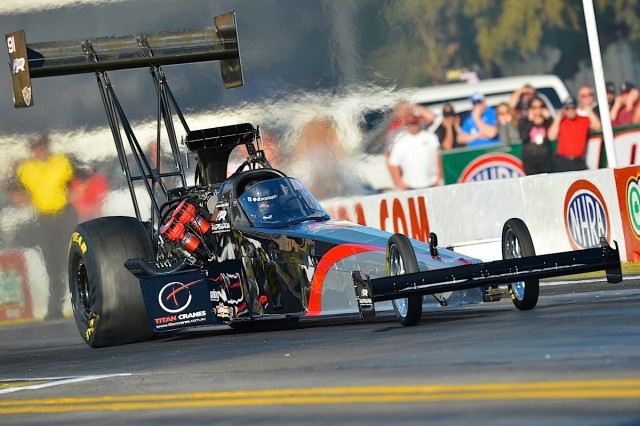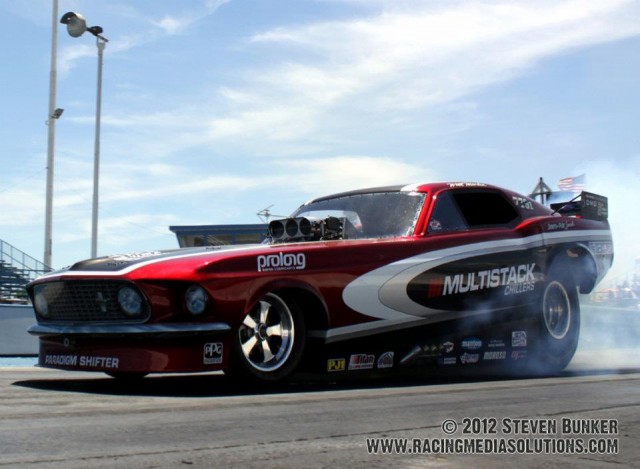With nitro engines reportedly approaching 10,000 horsepower, it’s no secret these engines must survive under the most brutal of conditions imaginable in all of motorsports. They encounter more destructive forces in four seconds than many other racing engines experience during an entire service life.
Lubrication becomes even more critical with performance at this level. Not only are parts failures catastrophic in terms of damage to the engine, they can also prove dangerous to the driver, should the failure results in loss of vehicle control. Prolong Super Lubricants has been conducting research and development on its Nitro Racing Oil for several years and recently released blends in 50 and 70 weight.

Three time NHRA Top Fuel Champion Larry Dixon uses Prolong oil in his Rapisarda Autosport Top Fuel Machine. Photo courtesty Rapisarda Autosport/Ron Lewis Photography
“The current Nitro Racing Oil is an improved version from the KB460 oil that was named for and run by the great Kenny Bernstein. However, we have made substantial improvements to it during extended testing that concluded a little over a year ago,” says Jon Apogée, Prolong’s general marketing manager.
Prolong’s Nitro Racing Oil begins with a premium synthetic base stock, then blended with an additive package that contains a detergent and rust inhibitor package.
Nitro basically turns oil into milk, or more like a runny mustard.
— Jon Apogée
Racing oil must offer extreme resistance to viscosity breakdown, even under the immense pressure and temperature associated with a nitro-powered engine. A key feature of Prolong’s Nitro Racing Oil is that it contains the company’s proprietary anti-friction metal treatment (AFMT) bonding technology. According to Prolong, this bonding technology plays a crucial role in improving characteristics of the oil; and the company adds that the AFMT does not contain any solids, including PTFE, molybdenum sulfides or plastics that could accumulate in the engine over time.
Prolong Nitro Racing Oil is available in either 50 or 70 weight, and is sold by the gallon, 5-gallon pail, or 55-gallon drum.
Most oils have good lubrication properties, as long as the oil is moving along metal surfaces. However, when oil pressure drops or is at zero, such as cranking an engine and the first few seconds after startup, wear occurs because oil isn’t flowing. According to Prolong, bonding technology literally adheres oil to the metal surfaces, providing enough lubrication to minimize wear until oil pressure returns. Phil Leatherman from the Extreme Automotive nostalgia nitro car team boasts, “Since we have been using Prolong’s oil we no longer have a bearing problem.”

The Extreme Automotive nitro car, Wild Thang, no longer has bearing issues after switching to Prolong nitro oil.
According to Prolong, AFMT bonding technology can fill the microscopic peaks and valleys found in metal surfaces. Even surfaces that are smooth to the touch can cause wear, as they are likely full of microscopic jagged edges.
“The protective layer formed by the molecules in bonding technology lubricates those surface irregularities through an extreme lubricating film pressure that fills in and evens out the peaks and valleys, diminishing the effects of metal-to-metal friction,” explains Apogée.
Apogée says that when a catastrophic engine failure occurs, AFMT can play a critical role in saving vital components. The company says race teams are reporting back that some components normally damaged by a lack of flowing lubrication may have been saved as a result of the AFMT technology.
“Though we don’t like hearing someone had a rod fail and blew an engine, we are glad we helped them save the rest of their engine components,” he says.
Resisting Dilution
Frequent oil changes
How much oil does nitro car use during a race weekend if it makes the final? That’s assuming three rounds of qualifying and four elimination rounds. With 16 quarts of oil changed each run, that’s 112 quarts, or 28 gallons of oil for one weekend. According to the Prolong web site, buying nitro oil in a 55 gallon drum makes the cost per gallon $42.22, so a weekend’s worth of oil cost a race team $1,182.
Dilution resistance is perhaps the most critical part of nitro oil design. While a high performance gasoline engine might run a fuel pump rated at 400-600 gallons per hour, a nitro engine fuel pump is running a firehouse amount of fuel at 100 gallons per minute. Since nitromethane is an oxygenated fuel, air/fuel ratios are close to a 1:1 ratio in Top Fuel, while other classes may run ratios running closer to 3:1. Most of the fuel is burned in the engine, but part of the nitro remains unburned, cooling the combustion event. As such, this unburned fuel must escape somewhere. While some exits out of the exhaust, much of the unburned fuel is sent past the rings and into the crankcase. This significantly dilutes the engine oil.
“Nitro basically turns oil into milk, or more like a runny mustard,” says Apogée.
The typical Top Fuel engine carries 16 quarts of oil. According to Top Fuel veteran Larry Dixon, “We could see as much as a gallon of nitro in our oil after a run. With that much dilution, you can’t put any oil in the car. It has to be designed for the amount of dilution that takes place in the crankcase.”
“We had two goals in mind with our Nitro Racing Oil. First, minimize dilution, and second, protect the moving metal parts of the engine, even if there was a catastrophic failure,” says Apogée.
During research and testing, Prolong noticed how quickly the oil pressure dropped in a nitro engine as a result of dilution. While the engine might have 240 psi oil pressure on the starting line, by the end of a pass oil pressure could be down to less than 100 psi.
As a result of these efforts, numerous teams running Prolong’s Nitro Racing Oil report higher oil pressures at the end of their runs, typically in the 140-160 psi range, according to Apogée.























